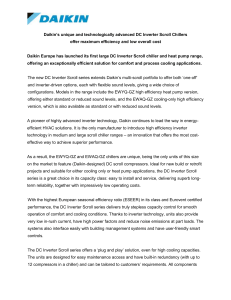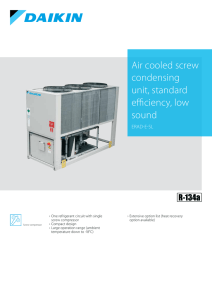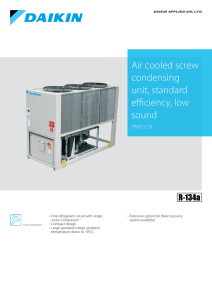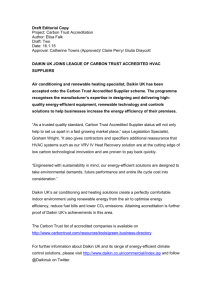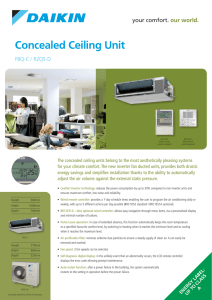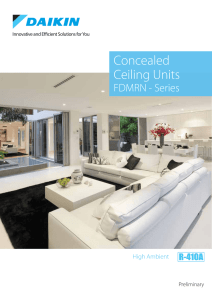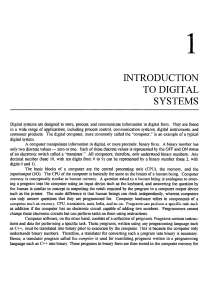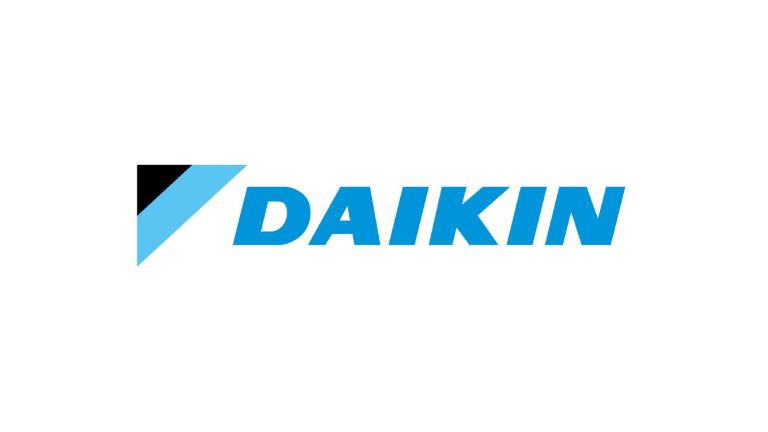
DAIKIN TZ-B: THE MOST EFFICIENT A/C SCREW CHILLER IN THE MARKET Applied Days Rome, 6th of October 2016 Green Building Design New Legislations New Technologies 3 GREEN BUILDING DESIGN 4 GREEN BUILDING DESIGN & CERTIFICATION DEFINITION Assessment used to demonstrate the environmental credentials of a building. SCOPE For clients, planners, development agencies, funders and developers: specify the sustainability performance of their building. For property agents: promote the environmental credentials and benefits of a building to potential purchasers and tenants. Key factors driving HVAC Market 5 GREEN BUILDING DESIGN & CERTIFICATION Score credits per BREEAM category* Credits % Max. Credits: *Based on BREEAM International New Construction 2013 14 12 10 Levels of certification: ≥ 85% Outstanding ≥ 70% Excellent ≥ 55% Very good ≥ 45% Good ≥ 30% Pass < 30% Unclassified 8 6 4 2 0 Key factors driving HVAC Market 6 Each category carries a certain weight that affects the score. TYPICAL HVAC ENERGY CONSUMPTIONS in OFFICES Ventilation Space cooling Hot water Space heating Manage up to 48% of your energy use Source: 1. EIA Commercial Buildings Energy consumption survey ; 2. Energy conservation centre, 2009 Key factors driving HVAC Market 7 NEW LEGISLATIONS 8 TARGET BY 2050 -80% CO2 emissions Key factors driving HVAC Market 9 Direct emissions F-GAS To cut the emissions of the F-gases (=fluorinated gases) into the atmosphere. Indirect emissions ECODESIGN Key factors driving HVAC Market 10 To set the minimum efficiency requirements for HVAC systems. NEW TECHNOLOGIES 11 New Technology Continuous evolution in components’ technology. Advanced technologies nowadays available at competitive prices. 12 Green Building Design Reduction of running costs and C02 emissions Increasing demand for New Legislations EU – low carbon roadmap International protocols New Technologies Continuous evolution in components’ technology Key factors driving HVAC Market 13 HIGH EFFICIENCY HVAC SYSTEMS OUR MISSION IN PRODUCT DEVELOPMENT ANSWERING MARKET DEMANDS OFFERING NEW OPPORTUNITIES ANTICIPATING FUTURE NEEDS 14 DAIKIN “TZ-B” The most efficient A/C screw chiller in the market 15 DAIKIN TZ-B Full inverter air cooled chiller Capacity range from 170 up to 1100 kW Daikin single screw compressor with integrated inverter and Variable Volume Ratio Best efficiency @ full load and part load DAIKIN TZ-B dual circuit single circuit 350 kW Standard sound Low sound Platinum -6 dB(A) vs standard Gold Silver Silver Efficiency 17 1100 kW 700 kW Noise level 150 kW Reduced sound -8 dB(A) vs standard DAIKIN TZ-B vs competition 6 DAIKIN TZ-B Platinum Part load efficiency (ESEER)* 5,5 DAIKIN TZ-B Gold DAIKIN TZ-B Silver 5 4,5 Competitor 1 Competitor 2 Efficiency level for Inverter screw market 4 Part load Efficiency level for non inverter screw market 3,5 100 18 200 300 *Performance according to EN14511 400 500 600 700 Capacity [kW] 800 900 1000 1100 1200 2000 1500 1000 0 -500 -1000 DAIKIN TZ-B: Full load efficiency (EER) @ Eurovent condition = 3,09 Part load efficiency (ESEER) =5,09 Best competitor inverter chiller: Full load efficiency (EER) @ Eurovent condition = 3,23 Part load efficiency (ESEER) =4,67 Standard fix-speed chiller : Full load efficiency (EER) @ Eurovent condition = 3,16 Part load efficiency (ESEER) =3,75 19 77 71 65 59 53 47 41 35 29 23 17 11 5 500 Ambient temp [°C] application: office building location: Madrid peak Cooling load:1790 KW Running hours per year: 2000 h Cost for electricity: 0,14 €/kW Requested 3 chiller 600 KW Load [kW] COMFORT COOLING DAIKIN TZ-B Best competitor Inverter chiller Standard fix-speed chiller running cost per year € 23.018 € 24.520 € 27.087 Saving with DAIKIN TZ-B on a life cycle (15 years) - € 22.530 € 61.000 ROI with Daikin TZ-B vs fix speed - - ~ 2,5 years Daikin technical solution for high efficiency 20 Daikin solutions for high efficiency Latest generation of Daikin single screw compressors Latest generation of Daikin single screw compressors Single screw VS twin screw Thanks to his characteristic geometry the single screw compressor is a better matching with inverter application compared to the twin screw 22 Latest generation of Daikin single screw compressors Single screw VS twin screw Twin screw casing Refrigerant leak Low pressure rotor High pressure The parabolic shapes lead to less quantity oil between rotor and stator, as a consequence is easier for the refrigerant to flow back from high pressure side to low pressure side. Single screw Casing Refrigerant leak Low pressure 23 rotor High pressure the single screw compressor is characterized by smaller distance between rotor and casing allowing to a smaller amount of refrigerant to flow back from high pressure to low pressure side Daikin solutions for high efficiency Latest generation Daikin design inverter screw compressors + Daikin’s unique single screw design for perfectly balanced loads combined with inverter technology Benefits of Inverter: Top Class Efficiency Compressor load Traditional mechanical Unloading with sliding valves Daikin unloading with inverter technology 100% load 100% speed 100% speed 50% load 100% speed + 50% speed mechanical unloading 25% load 100% speed + mechanical unloading 25% speed Power Input Benefits of Inverter: Top Class Efficiency 100 Screw Compressor With mechanical unloading 90 80 73% 70 -23% 60 Screw Compressor INVERTER driven 50% 50 Power consumption significantly reduced at part loads where the machine will run for 97% of operating hours (Eurovent). 40 30 20 10 0 0 10 20 30 40 50% 50 60 70 80 90 100 Compressor Load Other benefits of Inverter Reduced mechanical stress No inrush current 27 High power factor Lower noise level at part loads Daikin solutions for high efficiency Latest generation Daikin design inverter screw compressors with Variable Volume Ratio technology + + VVR Daikin’s unique single screw design for perfectly balanced loads combined with inverter technology And VVR (Variable Volume Ratio) Variable Volume Ratio The Volume Ratio (VR) is defined as follow Volume of gas at inlet suction of compressor Volume of gas at exit discharge of compressor and is linked to the Pressure Ratio VRk = Pressure of gas at exit discharge of compressor Pressure of gas at inlet suction of compressor (k is constant and depend from the refrigerant) The higher the Volume Ratio (VR), the higher the pressure of the gas at discharge The lower the Volume Ratio (VR), the lower the pressure of the gas at discharge 29 Variable Volume Ratio 𝑷𝑫𝒊𝒔𝒄𝒉𝒂𝒓𝒈𝒆 > 𝑷𝑪𝒐𝒏𝒅𝒆𝒏𝒔𝒊𝒏𝒈 Refrigerant is compressed more than needed to move it to condenser Over compression Efficiency loss 30 CONDENSER Variable Volume Ratio CONDENSER 𝑷𝑫𝒊𝒔𝒄𝒉𝒂𝒓𝒈𝒆 < 𝑷𝑪𝒐𝒏𝒅𝒆𝒏𝒔𝒊𝒏𝒈 Refrigerant flows back from condenser to compressor Under compression Efficiency loss 31 Variable Volume Ratio Variable Volume Ratio (VVR) means that VR can change by moving of sliding valves. VVR changes the point at which the gas leaves the compressor, and therefore changes the pressures at discharge which is always optimal at any condition. CONDENSER P B Pd = Pc DAIKIN VVR ALWAYS OPTIMAL CONDITIONS Variable POINT A A POINT B Ps V Vd Variable Vs Daikin solutions for high efficiency Latest generation Daikin design inverter screw compressors with Variable Volume Ratio technology + + VVR High efficiency EC fans DAIKIN TZ-B technology Last generation of Microchannel condensing coils Evolved control logic DC motor for compressors Economizer circuit controlled by electronic expansion valve 34 DAIKIN TZ-B Application flexibility COMFORT COOLING RENTAL Low Temperature application Data Center PROCESS COOLING HIGH AMBIENT Temperature 35 DAIKIN TZ-B Application flexibility COMFORT COOLING Low Temperature application RENTAL PROCESS COOLING HIGH AMBIENT Temperature Data Center 36 all applications needs high part load efficiency most common wrong believes We don’t need inverter units for process cooling due to the constant load In multiple chiller plant is better to shut down some units instead of running all of them in part load Inverter driven compressors are not suitable for applications in hot and/or dusty environment (e.g. industrial, rural, desert environment) 37 1) We don’t need inverter units for process cooling due to the constant load Load [kW] Process application (e.g. data center, cooling of industrial machinery) are characterized by constant loads during the year. In order to ensure that the load request is always satisfied, the chiller is designed to give the proper cooling capacity in the worst operating condition for the specific climate region @ design condition: Ambient: 35°C Required load 38 Chiller 100% capacity 1) We don’t need inverter units for process cooling due to the constant load While the load request is constant during the year the ambient temperature is not. The unit is selected to give the needed capacity at design condition, but for the most of the time will operate at different (more favorable) conditions, leading to different performances from the design (worst case). For most of the time the chiller is running in unload conditions !! chiller unloading80 Unit capacity in % of required load 130 % 70 120 % 60 110 % 50 40 100 30 20 80 10 0 70 39 jan feb march apr may june jul aug sept oct nov dec Ambient temp. [°C] required load (always 100%) 90 DAIKIN TZ-B: Full load efficiency (EER) @ Eurovent condition = 3,2 Part load efficiency (ESEER) =5,12 Non inverter chiller solution: Full load efficiency (EER) @ Eurovent condition = 3,21 Part load efficiency (ESEER) =3,77 40 42 500 500 37 400 32 Ambient temp [°C] application: cooling of industrial machinery location: Milan Cooling load: 500 kW Running hours per year: 8760 h Cost for electricity: 0,15 €/kW Load [kW] PROCESS COOLING 27 35 22 30 17 25 12 20 157 102 5 300 200 100 0 running cost per year ROI Daikin TZ-B Non inverter solution € 137.000 € 145.000 1 year Saving on chiller life time (15 years): € 120.000 2) In multiple chiller plant is better to shut down some units instead of running all of them in part load Typically in case of multiple chiller installation is considered a better solution to have more chiller that run at full load and stage the plant shutting down the chillers (and the related pumps) as the load decrease Plant load 66% Plant load 100% Plant load 33% Unit load Unit load Unit load Unit load Unit load Unit load Unit load Unit load Unit load 100% 100% 100% 100% 100% 0% 100% 0% 0% 41 2) In multiple chiller plant is better to shut down some units instead of running all of them in part load Thanks to the high efficiency in part load operation with inverter chiller can be more efficient to run all the chillers in part load (even considering “fix-speed” pumps on primary circuits) Plant load 66% Plant load 100% Plant load 33% Unit load Unit load Unit load Unit load Unit load Unit load Unit load Unit load Unit load 100% 100% 100% 66% 66% 66% 33% 33% 33% In case of variable speed pumps on primary circuits or in primary only plant with variable speed pumps, the benefits of the inverter chiller solution is even higher 42 COMFORT COOLING (design at 46°C ambient temperature) Running hours per year: 8760 h Cost for electricity: 0,11 €/kW 600 hours application: Hotel location: Dubai Cooling load: 2 MW Load [%] 500 100 400 80 300 60 200 40 100 20 0 0 16 18 20 22 24 26 28 30 32 34 36 38 40 42 44 46 48 50 Note: Fix speed pump on Primary plant Solution 1: 3 x Non inverter chiller Full load efficiency (EER) @ 46°C ambient = 2,42 Part load efficiency (ESEER) = 3,77 Solution 2: 3 x Daikin TZ-B Full load efficiency (EER) @ 46°C ambient = 2,34 Part load efficiency (ESEER) = 4,57 43 120 Ambient temperature [°C] running cost per year ROI DAIKIN TZ-B Non inverter solution € 201.780 € 226.000 ~ 1 year Saving on chiller life time (15 years): € 363.300 3) Inverter driven compressors are not suitable for applications in dusty environment (e.g. industrial, rural, desert environment) Daikin solution provides a refrigerant cooled inverter integrated on the compressor. The temperature of the inverter is kept within the acceptable limits regardless the environmental conditions the traditional solution with Air- cooled inverter 44 DAIKIN solution with integrated Refrigerant cooled inverter thanks to the most advanced technology and highest part load efficiency…. 45 DAIKIN TZ-B is always the best choice THANK YOU 46
